They say… 
Best beer and travel writing award 2015, 2011 -- British Guild of Beer Writers Awards
Accredited Beer Sommelier
Writer of "Probably the best book about beer in London" - Londonist
"A necessity if you're a beer geek travelling to London town" - Beer Advocate
"A joy to read" - Roger Protz
"Very authoritative" - Tim Webb.
"One of the top beer writers in the UK" - Mark Dredge.
"A beer guru" - Popbitch.

|
Originally published in What’s Brewing February 2005
Origin: Fremantle, Western Australia
ABV: 5.2 per cent
Buy from Sainsbury, Waitrose, Oddbins, specialist suppliers
 Little Creatures Pale Ale Aside from Coopers of Adelaide with their unique sparkling ales, Australia is a disappointing country beer-wise, awash with the sort of cheap and nasty lager that most discerning drinkers wouldn’t give a XXXX for. New brewpubs and micros are on the rise, however, and now one of their products has reached the UK.
The Little Creatures pub opened in 2000 on the fishing boat harbour at Fremantle, just outside Perth. The building was originally a boatyard and then a crocodile farm before being converted into a spacious modern brewpub.
Its original mission was to brew a well-hopped premium pale ale inspired by American examples. The resulting beer proved a major success with Australian critics and the public in a very short time, winning several trophies at the Australian International Beer Awards.
Australian malts are produced to the brewery’s specifications by a supplier in Ballarat. The beer is bottle-conditioned: in fact the name itself is intended as a reference to live yeast.
Hops figure highly in Little Creatures publicity: the brewery is proud of its large hopback. It is also the only brewery in Australia with a quarantine license allowing it to import and store whole hops from the USA. But rather than going for bitterness, the brewers have chosen to exploit the wide range of surprising flavours it’s possible to extract from the Cascade and Chinook varieties it selects for its pale ale.
The beer is a rich golden colour, with a light sediment and soft white lace. Take a sniff and you’re overwhelmed by aromatic fruit and flowers: honeysuckle, new mown hay, lychees and pineapple.
The refreshing palate is similarly rich in fruity hop notes: fruit salad, more pineapple, rosewater, fresh lemon and pine over a lightly syrupy malt backbone. More familiar bitterish hop resins become evident as the flavour develops.
Some bitterness does emerge on the swallow, slowly spreading in a long finish with more tangy flavours and a persistent honeysuckle and fruit lift. The hops become quite peppery, but always controlled and never overbitter.
Of course it wouldn’t take much to make a beer that looks good when compared with the desultory products of Australia’s megabrewers, but Little Creatures even stands up well in more international company: it could give some of its American inspirations a run for their money. Overall a light-hearted beer that gives this column a fresh and joyful start to 2005.
Try also ‘t IJ Plzeň (Netherlands, curiously similar to this beer), Sierra Nevada Pale Ale (USA), Butts Barbus Barbus (GB)
Read more about this beer at ratebeer.com: http://www.ratebeer.com/beer/little-creatures-pale-ale/7658/
Originally published in What’s Brewing January 2005
Origin: Knightwick, Worcestershire, England
ABV: 6 per cent
Buy from Brewery (tel 01886 821235, www.temevalley.co.uk ), specialist suppliers
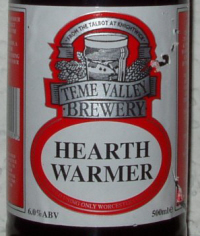 Teme Valley Hearth Warmer A few hundred years ago it wouldn’t have been uncommon for local breweries to keep their own patch of humulus lupus, but times have changed. When it was founded behind the Talbot, a celebrated 14th century coaching inn on the river Teme between Bromyard and Worcester, back in 1997, the Teme Valley Brewery became the only independent British brewer to use its own hops.
Pub and brewery are owned by the Clift family, who had also owned hop fields on the nearby Lulsley Court Estate, in the heart of Worcestershire’s hop growing country, since the 19th century. The estate was sold in September 2000, and while the brewery can no longer claim its singular distinction, it remains committed to local hops, with 90% coming from Lulsley Court and some of the beers using green hops fresh from the harvest.
These green hop beers by no means exhaust the noteworthy specialities in the brewery’s range. Hearth Warmer, which went by the punning name of Wass Ale when it was first launched as a draught Christmas beer in 1997, is one of the few British beers long matured at the brewery: it’s kept for up to nine months before release.
The real ale in a bottle version first appeared in December 2000, brewed from a complex grist of pale, crystal and chocolate malts with some wheat malt and roasted unmalted barley, plus locally sourced Northdown and Fuggles hops.
The result is a rich burgundy colour with an amber glow that pours with an off-white foamy head. The sweet-sour aroma is also striking, with plenty of sherberty, pastille-like fruit and hints of almonds.
The palate also makes an impression: it’s powerfully sweet and sour, with orange fruit, and the darker malts and roasted barley make themselves felt with unexpected but welcome roasty and chocolate notes.
There are toffee flavours in the swallow, leading to an intense finish with more fruity malt and a developing pleasant roast flavour. Unsurprisingly there’s a good dose of hops giving dry spiciness, but this never becomes overbearing, with plenty of sweet and juicy fruit and malt flavours still evident beneath the dryness.
The roasty flavours and the strength give Hearth Warmer the whiff of an old-fashioned country beer, calling to mind revivalist recipes such as Fullers 1845 and making it a particularly appropriate fuel for traditional seasonal cheer. If anything the flavours are a little too raw and vivid, and the beer could survive a bit more laying down after purchase, perhaps as a treat for the next festive season.
Read more about this beer at ratebeer.com: http://www.ratebeer.com/beer/teme-valley-hearth-warmer/39288/
Originally published in What’s Brewing December 2004
Origin: Vorchdorf, Upper Austria
ABV: 14 per cent
Buy from Specialist suppliers
 Schloss Eggenberg Samichlaus Bier Samichlaus, an ideal sipping beer for the festive season, used to be the world’s strongest regularly brewed beer, and still claims to be its strongest lager.
The name is Swiss German dialect for St Nicholas, aka Santa Claus, and the beer is brewed annually on his saint’s day, 6 December, in many European countries a jollier occasion than Christmas Day. It’s matured at the brewery for ten months before being released in time for the following season.
This Austrian brew’s Swiss name is explained by its origin at the Hürlimann brewery in Zürich, once a leader in the cultivation of pure yeast strains. It was first produced there in 1979 to test an experimental yeast that would not “go to sleep” at higher alcohol levels, but immediately became a regular speciality.
In 1996 Hürlimann merged with another big Swiss brewer, Feldschlösschen, and the combined group is now part of Carlsberg. Samichlaus was soon rationalised out of existence, but after an international outcry from enthusiasts, it was recreated under license across the border in Austria after a break of three years.
Its new home is at 10th century Castle Eggenberg, overlooking the village of Vorchdorf between Salzburg and Linz. The castle has boasted a commercial brewery since 1681: the Stöhr family, the present owners, date their involvement back to 1803.
The beer is made to the same recipe as before, including dark malts and Hallertau, Hersbrücker and Styrian hops. The original cold fermenting yeast brought from Hürlimann is now supplemented by a second strain from Eggenberg.
The beer comes out rich brown with a burgundy tinge, very slightly cloudy with a gentle carbonation and a low head that soon subsides. It has a malty, spirity aroma with touches of glacé cherry, fruit cake, sherry and old books.
There are also sherry notes on the sweetish, malty and very complex palate, with juicy cherry fruit and darker iron and coffee flavours. The alcohol is obvious but not overbearing and the texture is smooth rather than cloying, aided by the subtle sparkle.
Gently drying and slightly raspy hop tones emerge in the long, warming finish, which remains overall malty and fruity, with notes of sweet wine, brandy and dates. There’s also a faint but noticeable bitter and woody sting in the tail.
Although not bottle conditioned, Samichlaus is capable of bottle development — my sample was bottled in 2001 with a best before date of 2005 and certainly showed some additional complexity. A treasure of a beer, and one that deserves looking after following its narrow escape from corporate oblivion.
Read more about this beer at ratebeer.com: http://www.ratebeer.com/beer/schloss-eggenberg-samichlaus-bier/6245/
Originally published in What’s Brewing November 2004
Note this beer may no longer be available in a bottle conditioned version.
Origin: West Lydford, Somerset, England
ABV: 7 per cent
Buy from Specialist suppliers, regional Tesco
 Cottage Norman's Conquest Back in the mid-1990s this superb Somerset ale seemed poised to lead the bottled beer renaissance. When Cottage Brewery founder Chris Norman and his wife Helen dreamed up the rather high concept of a beer called Norman’s Conquest at an original gravity of 1066, they couldn’t have known the result would prove such a hit, snatching Champion Beer of Britain in draught form only months after it first appeared in 1995.
Seeing the potential in a bottled version but short of capacity in their then tiny plant, Cottage contracted out to Thomas Hardy. Bottle conditioned Norman’s Conquest was duly launched in some style at Fortnum and Mason in November 1995, at a time when the mainstream media seemed to be taking beer seriously for once: the Guardian raved, and Oz Clarke and Jilly Goolden rhapsodised on the BBC.
But the food and drink editors soon went back to glugging their supermarket Chardonnay, and Cottage ran into consistency problems. For a while Norman’s Conquest was brewed and marketed by Hampshire Brewery, then disappeared altogether in bottled form.
Eighteen months ago it made a welcome return, this time produced in house by a newly expanded brewery, and bottled at IBS, successor to Wessex Craft Brewers. Cottage’s Mark Dearman promises to build on its renewed success with at least three new bottled “classic ale styles” and a packaging upgrade by next spring.
Conquest is a beer that’s difficult to pigeon-hole; hardly the “barley wine” it’s sometimes designated, it’s more an idiosyncratic old ale with shades of a Belgian double. A grist of Maris Otter pale, crystal and chocolate malts and Challenger hops results in a beer that the label now describes simply as a “strong ale”.
It pours very dark ruby, with a fine, persistent yellowish head, and a roasty aroma with leather, vanilla, banana and cigar ash. It’s creamy in the mouth, with rich malt loaf and winey fruit and traces of raspberry, apple and brown sugar. Tar, chocolate, and hoppy, flinty flavours give some dryness.
The long finish has roast flavours coming to the fore over more malt loaf, hops and dry bitter chocolate on the tongue, and late cigar smoke and geranium notes.
All in all, the new Conquest seems at least as good as the old and should be just as well suited to fly the standard for fine British beer — if only the superplonkers of the media could be persuaded to wake up and smell the hops more than once a decade.
Try also Dent T’Owd Tup (filtered), Hog’s Back Wobble in a Bottle, Val-Dieu Brune (Belgium)
Read more about this beer at ratebeer.com: http://www.ratebeer.com/beer/cottage-normans-conquest/11408/
Originally published in What’s Brewing October 2004
Origin: Burton upon Trent, Staffordshire, England
ABV: 4.5 per cent
Buy from Specialist suppliers, brewery’s pubs, regional Tesco
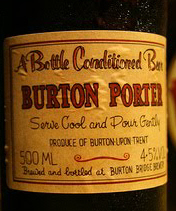 Burton Bridge Burton Porter There is a certain irony in a great porter coming from Burton upon Trent. Porter originated in 18th century London and became the first big commercial beer style, but it went into slow decline in the second half of the 19th century under competition from paler beers, and Burton, with its sulphate-rich waters ideal for working with new pale malts, became Britain’s new brewing capital.
Porter finally vanished after World War II, but the growing interest in traditional styles brought it back from the dead as a speciality in the late 1970s. Burton Bridge was established shortly afterwards in 1982, initially as a brewpub, by two ex-employees of what was then one of the town’s giants, Allied Breweries (Ind Coope). The brewery was an early pioneer of real ale in a bottle, appropriately in a town where one of the few remaining bottle conditioned ales of the older generation, Worthington White Shield, was still clinging on at nearby Bass.
Burton Porter, perhaps the longest-established of the revivalist porters, began as a draught festival special in 1983 and has been a steady seller as a bottled beer ever since. Interestingly, the brewery’s Geoff Mumford says it wasn’t intended as a simple recreation, but as a guess at how porter might have evolved if it had survived.
Once labelled with a simple stencil and a splash of yellow paint, its present more conventional paper label still maintains a minimalist style. The beer inside is made from crystal and chocolate malts besides pale, and hopped with Challenger and Target.
It’s a deep orangey-brown with reddish highlights and throws a copious bubbly fawn head. The aroma is tangy with orange and roast notes and a touch of caramel. The smooth palate is fruity and acidic, with an orange juice flavour that might be excessive were it not balanced by herbal, nutty and almost woody bitter hops and spicy liquorice flavours.
Hops move forward to dominate a drying finish whose bitterness is never excessive, with more nuts and herbs, sharpish fruit and some mineral tones. The beer bows out with a hint of bitter chocolate and roast notes on the tongue.
Some contemporary porters can’t make up their minds what distinguishes them from other dark beers like stouts and milds. Not so Burton’s entry, which combines roast and slightly sour flavours with the sort of drinkability you’d expect from a beer that quenched the thirst of manual workers to provide one of the best current interpretations of the style.
Try also Hogs Back OTT, Houston Teuchter (filtered), RCH Old Slug, Sierra Nevada Porter (USA)
Read more about this beer at ratebeer.com: http://www.ratebeer.com/beer/burton-bridge-burton-porter/5826/
Originally published in What’s Brewing September 2004
Origin: St Austell, Cornwall, England
ABV: 4.8 per cent
Buy from Supermarkets, brewery’s pubs, mail order
Website www.staustellbrewery.co.uk
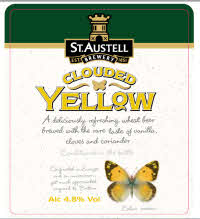 St Austell Clouded Yellow Clouded Yellow from St Austell, Cornwall’s only surviving traditional family brewery, must have one of Britain’s most evocative beer names. The clouded yellow is a butterfly, Colias Croceus, originating “in Europe and an uncommon yet much appreciated migrant to Britain” says the label, hinting at the beer’s exotic inspiration. But the name is also apt if interpreted literally. Clouded Yellow had a lucky escape — it could have been called Hagar the Horrible, the name under which it first appeared as a festival special back in 1999.
Brewer Roger Ryman had decided to have a go at a Bavarian-style wheat beer, but didn’t want to risk letting Bavarian yeast — responsible for many of the distinctive fruity and spicy flavours in these beers — loose in his brewery. Instead he tried using spices and flavourings, a practice strictly verboten in Bavaria, of course, but enthusiastically espoused by the brewers of that other great wheat beer country, Belgium.
A bottle conditioned version of this intriguing hybrid — mercifully renamed — won the Tesco Spring Beer Challenge the following year, and became a regular line. The recipe was tweaked further in 2003, reduced slightly in strength from 5 per cent, made rather less clovey and packed in more elegant green bottles.
It’s brewed from Maris Otter pale malt and malted wheat, hopped with Willamette and additionally flavoured with vanilla pods, cloves, coriander and maple syrup. Although brewed in Cornwall, it’s bottled at Hepworth’s in Horsham.
The beer is indeed yellow, and — if you pour with the traditional swirl — clouded, though less so than its continental inspirations. If this offends your delicate British sensibilities, the label suggests you can also pour it clear, but I think you’d be missing out.
There’s a thick, fine white head and a gently creamy, spicy and wheaty aroma with vanilla and banana tones. The very fruity banana and peach palate has emerging notes of vanilla, herbs and drying hops, none of which dominates.
The finish is mainly dry, with a deeper bitter tang that blends well with the vanilla flavour. There are late notes of orange peel, apple pips and cloves.
The beer is notably less spicy than it was, but still complex and unusual, and arguably more appealing. The brewery is keen to stress its suitability with food, recommending it with a Thai curry, but it’s also well worth drinking on its own, perhaps al fresco on a late September afternoon
Try also Baladin Isaac (Italy), Baltika 8 (Russia), Kaltenberg König Ludwig Weissbier (Germany), Salopian Puzzle
Read more about this beer at ratebeer.com: http://www.ratebeer.com/beer/st-austell-clouded-yellow/5731/
Originally published in What’s Brewing August 2004
Origin: Anderlecht, Brussels, Belgium
ABV: 5 per cent
Buy from Specialist stockists
Website www.cantillon.be
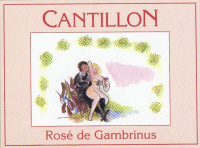 Cantillon Rosé de Gambrinus The lambic beers of the area in and around Brussels are the result of the ancient technique of “spontaneous” fermentation. Lambic brewers simply leave the wort exposed to the air overnight in a specially vented room so it becomes infected with wild yeasts, then seal it in closed vessels to continue fermentation.
Lambics contain a high proportion of unmalted wheat alongside lightly malted barley, with well-aged hops used as a preservative rather than for bitterness or aroma. To soften the sharp lactic character of the end result they are usually either sweetened, matured and blended or, most famously, flavoured with fruit such as sour cherries or raspberries.
Today lambic is a protected appellation of origin, and quite rightly so, because the success of the process and the character of the resulting beers is intimately linked to the local environment and its microflora. Even the room in which the wort is exposed makes a difference. As well as a goût de terroir, these beers even have a goût de chambre!
Big brewers have done their best to commercialise lambic production, resulting in a range of exotic fruit syrup concoctions dosed with enough sugar to keep the world’s dentists in business for centuries. But a few independents still offer more traditional, artisanal products and of these perhaps the most respected and uncompromising is the museum brewery of Cantillon, in the Brussels suburb of Anderlecht.
Lambics are always a challenge for the beginner since their taste is simply unlike any other beer, having more in common with real cider or fino sherry. Cantillon produces some of the most challenging examples of all, but you couldn’t find a better way in than Rosé de Gambrinus.
It’s an unfiltered, unpasteurised blend of two-year-old lambics and fresh raspberries, devised to contrast with the syrupy fruit beers of more commercial producers. But it’s also easily Cantillon’s most light hearted beer, its tone set by its cheekily playful label.
It pours a rich warm onion skin colour, lively and slightly cloudy, with a typical sharpish, musty and woody aroma, a sulphurous pinch and an immediate but restrained natural raspberry perfume.
The palate is tart, dry and puckering, softened by a subtle fruitiness with raspberry and cherry skin flavours and a touch of creamy vanilla. The finish is also tart, and very long, with dry cider, fresh lemon juice and tangy fruit.
Served lightly chilled in a champagne flute as suggested on the label, this most charming of lambics is a great al fresco treat on warm summer evenings.
Try also Cantillon Fou’Foune (apricot), Kriek Boon (cherry), Girardin Gueuze 1882 (black label), Hanssens Oudbeitje (strawberry)
Read more about this beer at ratebeer.com: http://www.ratebeer.com/beer/cantillon-rose-de-gambrinus/6014/
Originally published in What’s Brewing July 2004
Origin: Cologne, Nordrhein-Westfalen, Germany
ABV: 4.8 per cent
Buy from Specialist stockists
Website www.frueh.de
 Früh Kölsch Kölsch is one of those delightfully idiosyncratic wrinkles of regional popular culture that makes life worth living: a beer that’s become part of the identity of a city. It might look like a pale lager, but actually it’s an ale that successfully held its own small corner against the lager tide.
The Garde brewery claims credit for the first modern Kölsch in 1892, but the style really became a local phenomenon post-World War II. In 1986 its status was assured when all the local brewers signed the Kölsch Convention, limiting the geographical origins and regulating ingredients and character. Recognised by the German government in 1996, the Convention even specifies the correct glass, the narrow cylindrical “Stange”.
Among the brand leaders of the style is Früh — or Cölner Hofbräu P J Früh to use its official title. Founded by Peter Josef Früh in 1904, originally as a small, traditional city centre brewpub, it only began bottling in 1969. Its growing popularity saw the brewery itself move in the early 1990s to a modern site in the northern suburbs while the pub swelled to become the biggest in the city. The family remains in control, however, unlike some other local brewers that have already been absorbed by the likes of major German group Brau und Brunnen and Turkish-based multinational Efes.
Früh Kölsch’s popularity is well-deserved since it’s easily one of the best and most typical examples of the style, even in the bottle. The Convention demands a clear beer so it’s filtered, though unpasteurised and, being German, made according to the Reinheitsgebot (purity law) with only water, malt and hops — in this case Hallertau and Tettnanger, with a single strain house yeast.
The resulting beer is a very delicate pale golden colour, with a lively bead and a thick, slightly bubbly white head with a hint of yellow. There’s a slight fruit sherbert quality to the aroma, along with estery bubblegum and apple scents and a delicate trace of hops.
The palate is dry and light at first but soon develops a juicy richness that betrays its warm-fermented origins, with crisp but nutty malt, grassy and flowery hops and a slightly oily texture reminiscent of some of the stronger, maltier German lagers.
The finish is soft and fresh with a subtle whiff of vanilla, emerging tangy notes and a firm but not overstated flourish of hops. Overall, it’s a subtle, characterful and very refreshing beer that’s perfect for a warm summer day.
Try also genuine Kölsch from Dom, Garde, Reissdorf, Sünner; Sainsbury’s Taste the Difference “Kölsch style lager” (UK)
Read more about this beer at ratebeer.com: http://www.ratebeer.com/beer/fruh-kolsch/7777/
Originally published in What’s Brewing June 2004
Note this beer is no longer available in a bottle conditioned version, only in cask or filtered versions.
Origin: Cinderford, Gloucestershire, England
ABV: 6 per cent
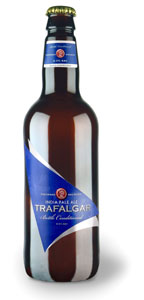 Freeminer Trafalgar India Pale Ale Freeminer Brewery, established in 1992 in the Royal Forest of Dean, is the source of some of the most distinctive and uncompromising bottled real ales in Britain: brews like seriously big Deep Shaft Stout or gingery Shakemantle wheat beer. The brewery celebrates the independently-minded local tradition even in its name: a “freeminer” is a local who has earned the ancient right to own a coal mine in the Forest.
Now, as Jeff Evans reported in last month’s Beer, the brewery is wisely investing spare cash from the cut in beer duty into marketing initiatives. As a result, several key bottled lines have had an image makeover, with labels and glassware more appropriate to high quality specialist products, and are enjoying supermarket listings.
Trafalgar is the brewery’s interpretation of a traditional India Pale Ale, strong and generously hopped to withstand a long sea voyage. At 6 per cent it’s a not quite 19th century strength but it’s also not one of the “inferior four point something” versions, as the brewery’s website puts it. It’s brewed from floor-malted Maris Otter pale malt sourced from Warminster Maltings in Wiltshire, with a touch of crystal and both wet and dry hopping with a single variety: Goldings grown around Ledbury, Herefordshire. Bottling is now at Marstons in Burton.
The result is a deep and glowing amber beer, quite dark for an IPA, with a busy sparkle and a thick yellowish head: a sticky sediment in my bottle made it easy to pour perfectly clear. Unsurprisingly, hops dominate a fresh and blossomy aroma, with touches of citrus, honey, faint gingery spice and hessian malt.
The complex palate is malty, soft and rounded at first, with traces of chaffy, cereal flavour and a slightly oily toffee quality. The hops kick in early, orangey at first and becoming quite bitter around the edges of the mouth. There’s perhaps some apple fruitiness and a slight burnt toffee flavour.
The finish brings a firm flourish of bitter hops, pronounced but never completely overwhelming tasty cereal malt. Big earthy resin tones emerge, turning more gentle and spicy as the finish develops.
Overall, this is a distinctive and flavoursome quality product, and it’s great to see it in packaging that does it justice: I’m not surprised to hear it’s doing well in posh Indian restaurants. Those brewers still disguising equally fine products with cartoon labels and laddish “joke” names take note.
Try also Burton Bridge Empire Pale Ale, Goose Island India Pale Ale (USA, filtered), Marstons Old Empire (filtered)
Read more about more recent versions of this beer at http://www.ratebeer.com/beer/freeminer-trafalgar-ipa/5832/29087/
Originally published in What’s Brewing May 2004.
Origin: Shefford, Bedfordshire, England
ABV: 4.3 per cent
Buy from Specialist stockists, brewery’s pubs, direct sales (tel 01462 815080, www.banksandtaylor.com)
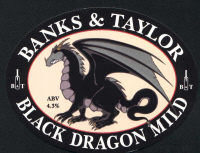 Banks & Taylor Black Dragon Mild As I noted this time last year, real mild in a bottle must be one of Britain’s rarest styles. Historically, “mild” refers to hopping rather than alcoholic strength, but these days people expect milds to be weak, and low strengths generally don’t bottle well. Some determined craft brewers are now reviving draught milds at more robust strengths, but few of these find their way into the bottle as live beers.
One that does is Black Dragon, from the B&T Brewery in the Bedfordshire market town of Shefford. This enterprise was launched as Banks & Taylor back in 1982; in 1994 it was sold to new owners and renamed B&T, though the full name is still used on labels. It now brews a range of over 30 beers including some excellent specialities.
Black Dragon was originally introduced in both cask and bottle conditioned form as a seasonal to celebrate Mild Month 2002 and has been revived every year since. At 4.3% ABV it’s the strength of a premium bitter, though still easily quaffable and several notches down on the strong milds of yesteryear.
It’s made from specialist mild malt, with 10% crystal, 8% black malt, 4% roasted malt and a touch of wheat malt for head retention, and hopped with Goldings. The bottled version is the same as the draught beer with a light sugar priming.
The result comes out a dark caramel brown, with a pale mushroom-coloured head that subsides to bubbles and lace, and a lively carbonation. The aroma is malty with slight roasted tones, and traces of treacle toffee, yeast and raspberry and redcurrant fruit.
The palate is light but full with an overall malty accent, but there’s also smoke and liquorice toffee. The rich malt is nicely balanced by acid sourness rather than hop bitterness, with sourish physali fruit giving the beer a slightly porterish character, and herbal flavours reminiscent of dandelion and burdock soft drink.
The beer finishes with an appealing and very moreish fruitiness, alongside more malt, smoke, and a drier, roasty edge with a touch of minerals. It’s notably long lasting and quite complex, with aromatic fruit tones emerging.
Overall this is an excellent interpretation of a rare and precious style that has evidently met with some deserving commercial success: B&T’s Mike Desquesnes tells me it’s likely to become a permanent, year-round fixture of the brewery’s range. Inspiration, I hope, for someone else to revive a strong bottled mild, so I’ll have something to review in next May’s column!
Read more about this beer at ratebeer.com: http://www.ratebeer.com/beer/b–t-black-dragon-mild/39712/
|
Cask  This pioneering new book explains what makes cask beer so special, and explores its past, present and future. Order now from CAMRA Books. Read more here. This pioneering new book explains what makes cask beer so special, and explores its past, present and future. Order now from CAMRA Books. Read more here.
London’s Best Beer  The fully updated 3rd edition of my essential award-winning guide to London’s vibrant beer scene is available now from CAMRA Books. Read more here. The fully updated 3rd edition of my essential award-winning guide to London’s vibrant beer scene is available now from CAMRA Books. Read more here.
|














